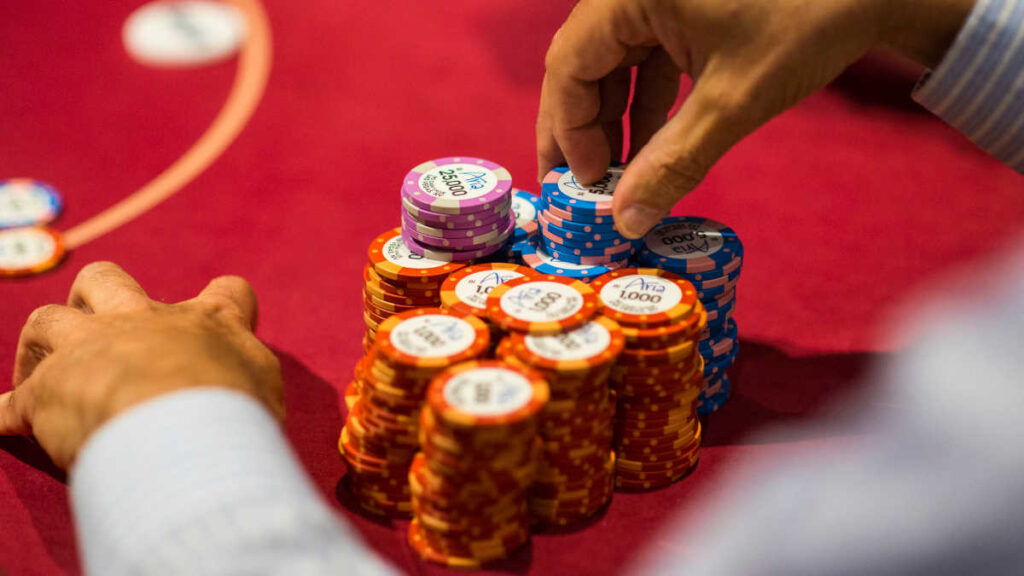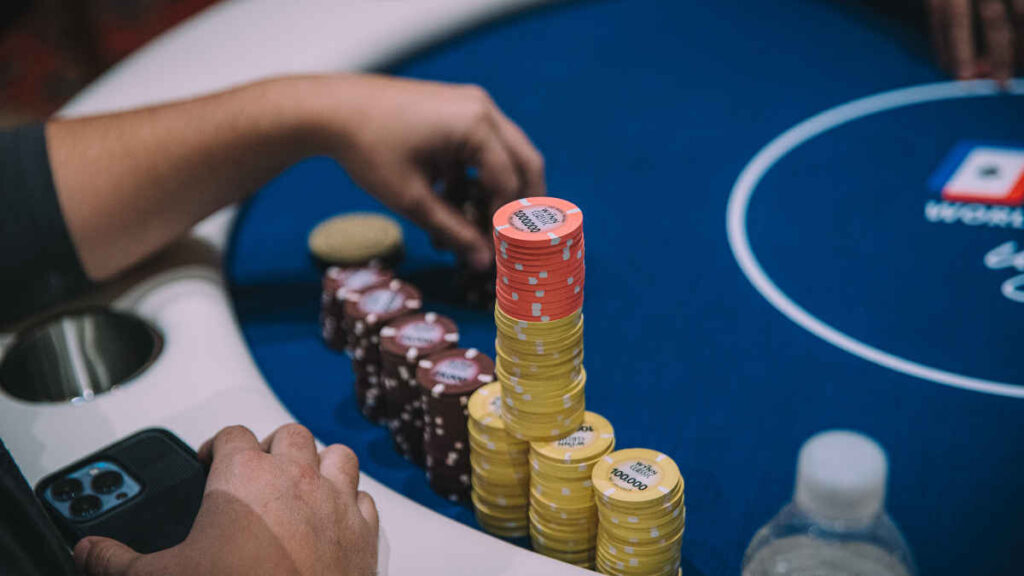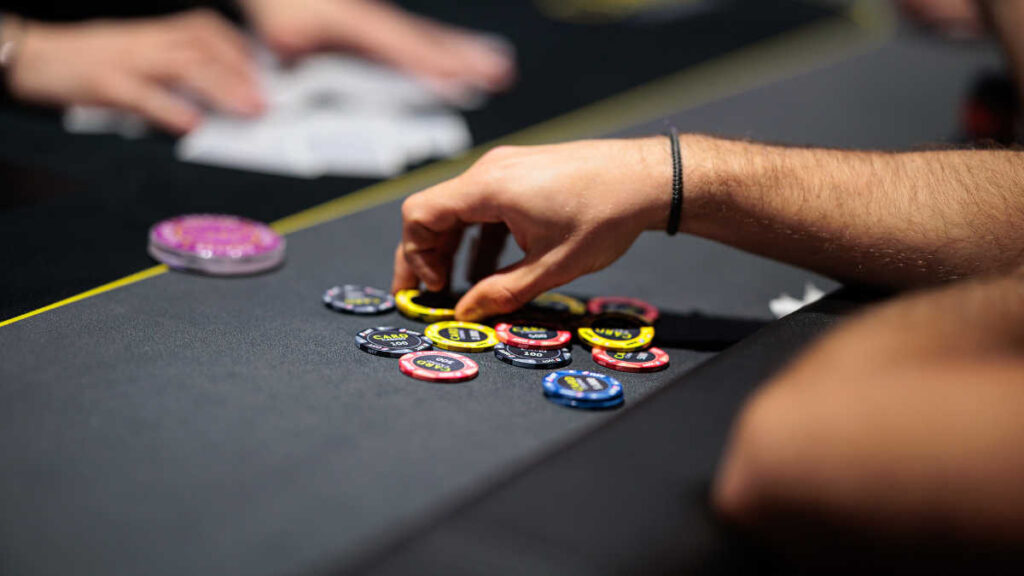Images courtesy of WPT.com
Forced bets like antes and blinds are an integral part of poker that gives sense to all betting and raising that happens over the course of a poker hand.
A poker ante is one of the most basic forms of a forced bet in poker, present in various poker games like Texas Hold’em Poker, Pot Limit Omaha, Seven Card Stud, and more.
If you are new to poker, and not yet familiar with how ante bets work, keep on reading and learn everything you need to know about poker ante bets and the part they play in poker strategy.
What Is an Ante Bet in Poker?
Before we can talk about different types of ante bets and their role in various poker games, we need to understand what an ante bet is, and what it is not.
Poker amateurs often refer to any forced bet in a poker game as an ante bet. This is an incorrect interpretation, as other forms of forced bets exist, such as blind bets.
An ante bet is specifically a small forced bet taken from every player at the table before other forced bets, such as the blinds and the bring-in, are posted.
In games like Seven Card Stud and Razz, ante bets are obligatory every hand, both in cash game and tournament formats.
In other poker games, such as Texas Hold’em Poker, ante bets are usually found in tournament formats, while cash games rely on blinds and straddles as the main bets to drive the action.
Purpose of Ante Bets in Poker
Much like other forced bets, ante bets are used to drive the action and give players a reason to enter pots with more than the very best hands.
For example, a $10/20 Seven Card Stud game will usually have a $1 ante paid by each player at the table before the cards are dealt. Once the cards are dealt, the player with the lowest up-card also posts a bring-in, which is worth $5.
If the bring-in was the only forced bets, there would be only $5 in the pot when the action starts. What’s even more, only one player at the table will have a financial investment in the pot.
On the other hand, if all eight players at the table pay a $1 ante, the pot grows to $13 immediately, and each player must pay $1 to play the hand.
This creates added incentives for players to try to take the pot down, as winning $13 is much different than winning $5 in a limit poker format like this.
Antes serve a similar purpose in tournament poker. For example, in a Texas Hold’em tournament with blinds at $500/$1000, each player may be forced to pay an ante of $100.
The added chips in the pot create more incentive for each player to open the pot for a raise, in order to try and take down the blinds and the antes.
Typically speaking, poker games with antes generate more action, which is why you will often play the highest-stakes cash games played with active antes.
Big Blind Ante in Tournament Poker

Over the year, tournament poker structures have changed in many ways. Most tournaments introduced ante bets at some point, while a more recent development has been the introduction of big blind ante.
For the most part, online poker tournaments still continue to charge ante bets from every player at the table, as the collection process is automatic.
On the other hand, tournament directors realized that the collection of antes in every pot was tedious and slow in live tournament settings. For that reason, they invented the big blind ante as a simple solution to the problem.
As the name suggests, the big blind ante is paid by the player in the big blind, and is typically worth the same amount of chips as the big blind.
For example, at $1000/$2000 blinds in a tournament, players would typically post a $200 ante each. In a big blind ante structure, the player in the big blind posts a $2000 big blind ante, while other players don’t post any antes.
With this structure, the pot size remains nearly the same, while action flows faster, as the dealer is not forced to collect antes from all players at the table.
It is worth noting that, in many casinos, the big blind ante is cut in half once the table gets short-handed, which makes the preflop pot size more closely resemble a typical ante structure.
Effects of Ante Bets on Poker Strategy
The addition of an ante bet in a poker game has significant strategic implications, although they might not be clear to an untrained eye.
Antes make the pot bigger to begin with, and this alone should greatly impact how you approach the game.
Amateur players, for the most part, don’t adjust their strategy much when antes are added, as they don’t understand the inherent value of winning the extra chips in the pot.
Poker professionals, on the other hand, understand the implications of antes. As such, they typically adjust by expanding their hand ranges across the board.
If you want to play well in a poker game with ante bets, you should be raising more pots first in, 3-betting more often, and introducing 4-bet bluffs into your game.
Playing looser may be an intimidating concept to a poker beginner, but it is the only way to truly adjust to the addition of ante bets in a poker game.
Keep in mind that antes are typically used in tournament poker play these days, and their impact there is even greater.
For example, if you have a 20,000 chip stack at the 500/1000 blind level without antes, winning the 1,500 chips in the pot will only increase your chip stack by 7.5%. On the other hand, winning 2,500 chips when the big blind ante is introduced will increase it by 12.5%, which is a significant difference.
As your chip stack dwindles in a poker tournament, winning the blinds and antes becomes more important, and more profitable, encouraging aggressive play and loose starting hand ranges.
Things to Consider When Stealing the Antes

Stealing the antes, along with the blinds, is an incredibly enticing idea in poker tournaments. However, there are some things you should remember when such nefarious ideas come to mind.
Looking at sheer math and solver ranges, it is clear that poker antes force you to play much looser ranges from all positions.
For example, the GTO opening range from early position can go from as low as 10% to as high as 20% when antes are introduced, showcasing just how significant of an impact they have.
Yet, antes also create room for exploitative play, and knowing how other players adjust to them can be a key piece of information.
Some players, especially amateurs, don’t really change their ranges too much when antes are introduced. Against such players, you can play even more aggressively when you are the first one raising, but should be more careful if they raise from early position.
On the other hand, when playing against very aggressive opponents, you can adjust by playing tighter than GTO strategy suggests, which allows you to crush their overly wide ranges.
The most important person at the table to consider is the player in the big blind, as they are the most likely to defend against your raises.
If you are in late position and raising against a relatively tight big blind, you can get away with raising 100% of all hands when antes are in play.
On the other hand, if the big blind is a very aggressive player, tighten up your ranges and print money when they 3-bet you too wide and defend with junk.
Ante Bets and Cash Game Poker
You won’t see too many public cash games with ante bets these days, as No Limit Hold’em and Pot Limit Omaha cash games aren’t typically played with them.
However, antes are often introduced in private games, and for a good reason. They generate a ton of action, especially when they are relatively big compared to the blinds.
For example, a $2/$5 game can benefit greatly from a $1 ante paid by each player. This punishes players who play too tight, and creates a lot of action and new opportunities to exploit your opponents.
Instead of playing the same old GTO ranges, players are now forced to create a limping strategy, adapt to limpers, and generally loosen up their ranges.
If you have never played a cash game with antes, you may want to try it in your home game, as we guarantee you and everyone else involved will appreciate the extra dynamics antes bring to the game.
Keep an Eye Out for Antes in Your Poker Games
Poker antes are small, and can seem insignificant at times. Yet, they can make all the difference in the world when you sit down at the poker table.
We have gone over the key implications that ante bets can have for your poker strategy, but there is always more to learn.
The next time you play a poker game with antes, remember to take them into account and adjust your strategy by going for more steal and re-steal attempts.
FAQ
What is a poker ante?
Ante is a small forced bet in poker games (usually a small percentage of the blind bet), that every player at the table pays before the cards are dealt.
What is the purpose of antes in poker?
Poker antes serve the purpose of increasing the size of the pot and driving action. Games with antes tend to be a lot more active and loose.
Who has to pay an ante in poker?
If antes are in-play, every player at the table must pay the ante, unless the big blind ante rule is in place.
What is a big blind ante?
A big blind ante is a big ante bet paid by the player in the big blind. In this case, the big blind “covers” the antes for the entire table.
What impact do antes have on poker strategy?
Typically speaking, poker antes encourage looser and more aggressive play, as the extra chips in the pot provide incentive for players to play more hands.


